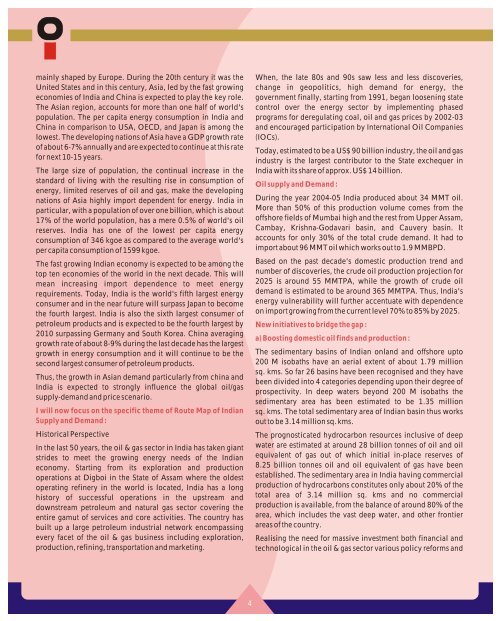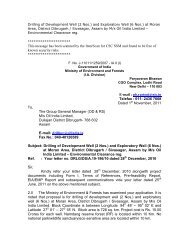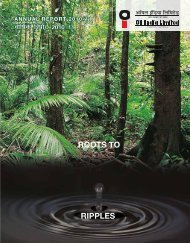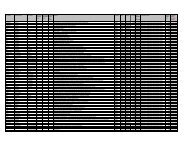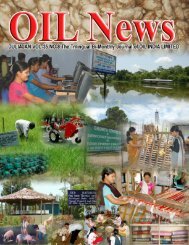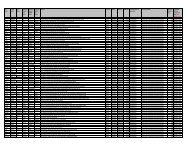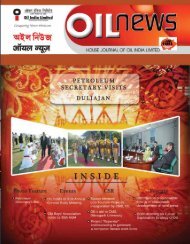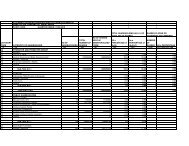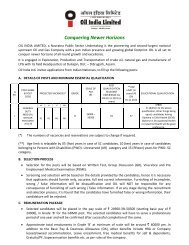2006 - Oil India Limited
2006 - Oil India Limited
2006 - Oil India Limited
You also want an ePaper? Increase the reach of your titles
YUMPU automatically turns print PDFs into web optimized ePapers that Google loves.
mainly shaped by Europe. During the 20th century it was the When, the late 80s and 90s saw less and less discoveries,<br />
United States and in this century, Asia, led by the fast growing change in geopolitics, high demand for energy, the<br />
economies of <strong>India</strong> and China is expected to play the key role. government finally, starting from 1991, began loosening state<br />
The Asian region, accounts for more than one half of world's control over the energy sector by implementing phased<br />
population. The per capita energy consumption in <strong>India</strong> and programs for deregulating coal, oil and gas prices by 2002-03<br />
China in comparison to USA, OECD, and Japan is among the and encouraged participation by International <strong>Oil</strong> Companies<br />
lowest. The developing nations of Asia have a GDP growth rate (IOCs).<br />
of about 6-7% annually and are expected to continue at this rate<br />
Today, estimated to be a US$ 90 billion industry, the oil and gas<br />
for next 10-15 years.<br />
industry is the largest contributor to the State exchequer in<br />
The large size of population, the continual increase in the <strong>India</strong> with its share of approx. US$ 14 billion.<br />
standard of living with the resulting rise in consumption of<br />
<strong>Oil</strong> supply and Demand :<br />
energy, limited reserves of oil and gas, make the developing<br />
nations of Asia highly import dependent for energy. <strong>India</strong> in During the year 2004-05 <strong>India</strong> produced about 34 MMT oil.<br />
particular, with a population of over one billion, which is about More than 50% of this production volume comes from the<br />
17% of the world population, has a mere 0.5% of world's oil offshore fields of Mumbai high and the rest from Upper Assam,<br />
reserves. <strong>India</strong> has one of the lowest per capita energy Cambay, Krishna-Godavari basin, and Cauvery basin. It<br />
consumption of 346 kgoe as compared to the average world's accounts for only 30% of the total crude demand. It had to<br />
per capita consumption of 1599 kgoe.<br />
import about 96 MMT oil which works out to 1.9 MMBPD.<br />
The fast growing <strong>India</strong>n economy is expected to be among the Based on the past decade's domestic production trend and<br />
top ten economies of the world in the next decade. This will number of discoveries, the crude oil production projection for<br />
mean increasing import dependence to meet energy 2025 is around 55 MMTPA, while the growth of crude oil<br />
requirements. Today, <strong>India</strong> is the world's fifth largest energy demand is estimated to be around 365 MMTPA. Thus, <strong>India</strong>'s<br />
consumer and in the near future will surpass Japan to become energy vulnerability will further accentuate with dependence<br />
the fourth largest. <strong>India</strong> is also the sixth largest consumer of<br />
petroleum products and is expected to be the fourth largest by<br />
2010 surpassing Germany and South Korea. China averaging<br />
growth rate of about 8-9% during the last decade has the largest<br />
growth in energy consumption and it will continue to be the<br />
on import growing from the current level 70% to 85% by 2025.<br />
New initiatives to bridge the gap :<br />
a) Boosting domestic oil finds and production :<br />
The sedimentary basins of <strong>India</strong>n onland and offshore upto<br />
second largest consumer of petroleum products.<br />
200 M isobaths have an aerial extent of about 1.79 million<br />
sq. kms. So far 26 basins have been recognised and they have<br />
Thus, the growth in Asian demand particularly from china and<br />
been divided into 4 categories depending upon their degree of<br />
<strong>India</strong> is expected to strongly influence the global oil/gas prospectivity. In deep waters beyond 200 M isobaths the<br />
supply-demand and price scenario.<br />
sedimentary area has been estimated to be 1.35 million<br />
I will now focus on the specific theme of Route Map of <strong>India</strong>n<br />
Supply and Demand :<br />
sq. kms. The total sedimentary area of <strong>India</strong>n basin thus works<br />
out to be 3.14 million sq. kms.<br />
Historical Perspective<br />
In the last 50 years, the oil & gas sector in <strong>India</strong> has taken giant<br />
strides to meet the growing energy needs of the <strong>India</strong>n<br />
economy. Starting from its exploration and production<br />
operations at Digboi in the State of Assam where the oldest<br />
operating refinery in the world is located, <strong>India</strong> has a long<br />
history of successful operations in the upstream and<br />
downstream petroleum and natural gas sector covering the<br />
entire gamut of services and core activities. The country has<br />
built up a large petroleum industrial network encompassing<br />
every facet of the oil & gas business including exploration,<br />
production, refining, transportation and marketing.<br />
The prognosticated hydrocarbon resources inclusive of deep<br />
water are estimated at around 28 billion tonnes of oil and oil<br />
equivalent of gas out of which initial in-place reserves of<br />
8.25 billion tonnes oil and oil equivalent of gas have been<br />
established. The sedimentary area in <strong>India</strong> having commercial<br />
production of hydrocarbons constitutes only about 20% of the<br />
total area of 3.14 million sq. kms and no commercial<br />
production is available, from the balance of around 80% of the<br />
area, which includes the vast deep water, and other frontier<br />
areas of the country.<br />
Realising the need for massive investment both financial and<br />
technological in the oil & gas sector various policy reforms and<br />
4


